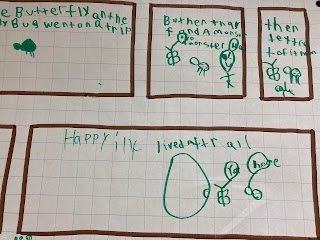There are only three weeks left of the 2021-22 school year left; counting today, Monday June 13, that's 14 teaching days. As the intensity of finalizing report card marks subside, the question of "what do we do in the meantime" surfaces. Many of these late June activities won't be able to appear on the report cards because of time constraints, but learning shouldn't be dictated by what can and cannot be included on those final evaluations.
Two sets of tasks that were able to make it onto that official document we are also able to continue for our final classes in kindergarten and they have to do with comics and dominoes.
Comics
For our library periods, the kindergarten students and I have been looking at comics. During free time, there are some students that choose to read graphic novels instead of play with toys, which delights my teacher-librarian heart. We went over some of the basic codes and conventions of comics and then got into teams to create our own comics. The teams told me how many panels and what shapes the panels had to be on their large chart papers. The results demonstrated to me why the kindergarten program is two years long.
Some students understood the concepts right away. They merged ideas. They experimented with making their own speech bubbles and filling them with words their characters said. Some even had a narrative structure, with a beginning, middle, and end. (Naturally, I took photos of the ones that impressed me the most.)
Then there were students that have made significant gains over the year but aren't quite there yet. They drew people in their panels but didn't understand directionality, so they were sideways and upside-down. Others drew people but when I came to assist them with their speech bubbles, they had no idea who the people they drew were, or what they could be saying. The idea of continuity between panels hasn't developed yet for them.
Then there were students who just scribbled or coloured in the boxes and shapes.
I'm glad we have a few weeks more so we can continue to have time to explore comic creation, read some comics, and teach.
Dominoes
In media, we focused on agency and decision-making. We looked at some games to determine how much player agency they allowed. The students, with some prompting, began to realize that certain games, such as tic-tac-toe, give players the power to make decisions. Other games, such as Chute and Ladders or Candyland, can proceed without the players making any choices of their own because the probability tool (cards or dice) make all the decisions for them. It's interesting to note that many board games targeted at young children rely on probability rather than player skill. I am teaching the students how to play dominoes, both with online and face-to-face resources. I bought a huge wooden set of dominoes (with my own money) to use in the library. I noticed that most children only know about lining up the dominoes to knock them down in a pattern, rather than using the pips to actually play the game. It's going to take us several times of playing for the students to grasp the game rules and strategies. It's also great for math (number sense and even geometry as they turn the tiles to match the numbers) and for cooperative skills (turn taking, consulting with team members about the best tile to place). Here are a a few photos of the students in action.




As part of their media evaluation, I asked them which method they preferred to use - the online dominoes or the in-person one. The students also had to articulate what techniques drew the players in to get them to keep playing. It was fascinating to see that many of the learning-in-person students commented on the computer version's attraction, whereas the learning-online students (who only could see me and their ECE playing the physical version together via their screens) tended to suggest that the face-to-face model was more appealing. I also find that their patience for the length of a game is quite short.
I'm glad I can introduce the game of dominoes to the students. My parents used to play dominoes with a set that they brought up with them from Guyana and there are some fond memories associated with the game.












.png)


